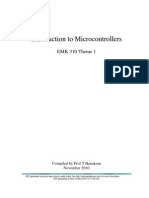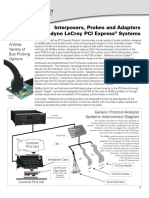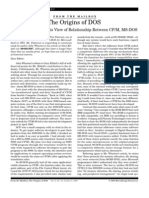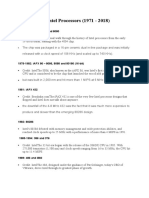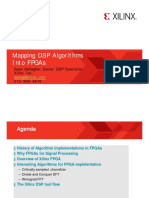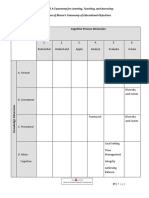Mapping DSP Algorithms Into Fpgas
Uploaded by
Mayam AyoMapping DSP Algorithms Into Fpgas
Uploaded by
Mayam AyoMapping DSP Algorithms
Into FPGAs
Sean Gallagher,Senior DSP Specialist,
Xilinx Inc.
seang@xilinx.com
215-990-4616
Page 2
Agenda
History of Algorithm implementations in FPGAs
Why FPGAs for Signal Processing
Overview of Xilinx FPGA
Interesting Algorithms for FPGA implelentation
Critically sampled channlizer
Divide and Conquer DFT
Winograd FFT
The Xilinx DSP tool flow
Page 3
History FPGAs for Algorithm Implementation
Systolic Array processing techniques were established in the
70s
S.Y. Kung, others
FPGA technology invented by Xilinx in 1984
Glue logic integration
Super Computing Research Center (SRC) built Splash I and II
coprocessing boards in early 90s
Board of 32 Xilinx FPGAs slaved to a Sun workstation
Computation speeds of 6-7 times greater than a Cray II computer
Page 4
My History With FPGAs
Visited SRC in early 90s to sell synthesis tools
Had no clue what they were talking about
Pursued MSCE at Villanova focused on algorithms in FPGAs
They had no idea what I was talking about
Masters thesis in 95, Implementing Algorithms in FPGAs
Came to Xilinx in 2001 as DSP Specialist
Still learning
Lowest Power
and Cost
Industrys Best
Price-Performance
Industrys Highest
System Performance
and Capacity
Handheld portable
ultrasound
Digital SLR lens
control module
Software defined radio
Wireless LTE infrastructure
10G PON OLT line card
LED backlit and 3D video
displays
Medical imaging
Avionics imaging
100GE line card
300G bridge
Terabit switch fabric
100G OTN
MUXPONDER
RADAR
ASIC emulation
Test & Measurement
Test &
Measurement
Next Gen Wireless
Communications
Emerging Applications Drive Demand for
Next Generation FPGAs
Automotive
Infotainment
Audio Video
Broadcast
Next Gen Wired
Communications
Aerospace
& Defense
Consume
r
Medical
Imaging
Page 5
Page 6
Why FPGA for Signal Processing?
1 GHz
256 clock cycles
= 4 MSPS
500 MHz
1 clock cycle
= 500 MSPS
- How much computational power do you need?
Page 7
Flexibility
- Howmany MACs (multiply accumulator) do you need?
- For Example, in FIR Filter,
ClockRate ate InputDataR
annels NumberOfCh ps NumberOfTa Rate OutputData
*
* *
required MACs of Number =
+
+
D Q
+
+
+
+
D Q
+
+
+
+
+
+
Parallel Semi -Parallel Serial
FPGAs can meet various throughput requirement
Speed Area
Page 8
Multi-Channel Friendly
LPF
Multi Channel
Filter
80MHz
Samples
ch1
ch2
ch3
ch4
LPF
LPF
LPF
LPF
20MHz
Samples
Parallelism enables efficient implementation of multi-channel into a single
FPGA
Many low sample rate channels can be multiplexed (e.g. TDM) and
processed in the FPGA, at a higher rate
Many of Xilinx IPs takes advantage of multi-channel implementation -
FIRCompiler, FFT
Page 9
C6416 C6416
100 MHz
100 kHz
100 kHz
FPGA as pre-processor
500 MHz 500 MHz
C6416 C6416
FPGA as co-processor
FPGA + DSP Processor
FPGA enables DSP processor acceleration mapping speed critical
loop of DSP code to FPGA
FPGAs enables consolidation of glue logic, memory, interfaces, ASSP
For detail on interface (EMIF,VLYNQ,LinkPort), see
http://www.xilinx.com/esp/wireless.htm
6 Series Xilinx FPGAs
Virtex-6 - Industry leading DSP performance
Spartan-6 Industry leading DSP cost / performance
Page 10
Industries Best
Price/Performance
Industries Highest
System Performance
Logic Cells 3.8K 147K 74K 567K
DSP Slices 8-180 288-2016
Max Transceivers 8 72
Transceiver
Performance
3.125 Gbps 6.6 Gbps
11.18 Gpbs
Memory 4,824 Kbits 38,309 Kbits
Max. SelectIO 576 1200
SelectIO Voltages 1.2v to 3.3v 1v to 2.5v
Now Shipping
Introducing the 7 Series FPGAs
Industrys Lowest Power and First Unified Architecture
Spanning Low-Cost to Ultra High-End applications
Three new device families with breakthrough innovations in power
efficiency, performance-capacity and price-performance
Page 11
Bridging the DSP Performance Gap with 7-Series
33 GMAC
770 GMAC
4752 GMAC
Virtex-7
Kintex-7
Time
Virtex-
6
Spartan-6
90 GMAC
2000 GMAC
6-Series
7-Series
DSP Performance
Multi-core DSP Architectures
* Peak performance for symmetric filters
Page 13 Virtex-6 Base Platform 13
FPGA Resource
BRAM BRAM
Switch
Matrix
DCM
CLB,
IOB,
DCM
DSP48 DSP48
Logic Fabric Logic Fabric
Virtex-6 Overview 13
=
B
A
D
+/-
25x18
MULT
25
18
48 P
25
25
C =
B
A
D
+/- +/-
25x18
MULT
25
18
48 P
25
25
C
Challenge: How do we make the best
use of these resources in most
efficient manner?
Page 14
DSP Performance through the DSP48E1 Slice
Virtex-6, Artex-7, Kintex-7, Virtex-7
2 DSP48E1 Slices / Tile
Column Structure to avoid routing delay
Pre-adder, 25x18 bit multiplier, accumulator
Pattern detect, logic operation, convergent/symmetric rounding
638 MHz Fmax
+/-
X
=
B
A
D
C
+
-
Pre-Add
25x18
Pattern
Detector
48-Bit Accum
P
DSP48E1
Slice
DSP48E1
Slice
I
n
t
e
r
c
o
n
n
e
c
t
DSP48 Tile
DSP48E1 Slice
Pre-Adder
Hardened Pre-Adder leverages
filter symmetry to reduce Logic,
Power and Routing
No restriction to coefficient table
size
Coefficients c
n
Filter symmetry
exploited to pre-add
tap delay values and
reduce multiplies by
50%
Greater Flexibility with Fully Independent Multipliers
Full, independent access to every multiplier
One accumulator for each multiplier
5 Interconnects support up to 50 bit multiplies per tile
DSP48E1
Slice
DSP48E1
Slice
I
n
t
e
r
c
o
n
n
e
c
t
DSP48 Tile
25x18 Multiplier
Single DSP slice supports up to
25x18 multiplies
50% fewer DSP resources required
for high-precision multiplies
Efficient FFT Implementations
Efficient single-precision floating-
point implementations
Single DSP Tile supports up to
50x36 multiplies
Delivers higher performance and
lower power
Efficient Rounding Modes using Pattern Matching
Only FPGA architecture
that supports pattern
detection
Pattern can be constant (set by
attribute) or C input
Efficient implementation of
rounding modes
Symmetric
Convergent
Saturation
One Accumulator for each Multiplier
DSP48E1 slice provides an
accumulator for each
multiplier
2X more than competitive
architectures
Up to 48-bits accumulation per DSP
slice
25x18 multiply
Up to 96-bits accumulation per DSP
tile
50x36 multiply
20
DSP IP Portfolio
Comprehensive IP portfolio
Constraint Driven
IP can be imported into RTL,
System Generator and
Platform Studio
Category IP Blocks
Math mult, adder, accumulator,
divider, trig, CORDIC
Filters FIR, CIC
Memory RAM, register, FIFO, shift
register
Transforms FFT, IFFT, LTE FFT
Processors MicroBlaze
Video Color correction, CFA, pixel
correction, image
characterization, edge
enhancement, noise reduction,
statistics, CSC, VFBC, Scaler,
timing controller,
Wireless DDS, DUC/DDC, MIMO
Decoder/encoder, RACH
preamble det, DPD, CFR,
Floating-Point Add/sub, mult, div, sqrt,
compare, convert, FFT
Constraint Driven IP
21
FIR Compiler
6.0
Parameter Result 1 Result 2 Result 3 Result 4
Channels 2 2 4 4
Clock Frequency 122.7 245.4 245.4 368.1
DSP Slice Count 3 1 3 1
30.22 MHz 61.44 MHz
Interpolate by 2
11 Tap FIR Filter
Overclocking automatically used to reduce DSP slice count
Quick estimates provided by IP compiler GUI
Insures best results for your design requirements
Interesting Algorithms For FPGA
Implementation
22
Critically sampled channelizers
Polyphase with a DFT bank
Divide and conquer DFT
Calculating a 1D FFT as a 2DFFT
Winograd FFT Transform
Least amount of multiplies
Channelization 23
Passband Polyphase Filters
In a FDM digital communication system a common
requirement is, for each channel:
translate the channel to baseband
shape the channel spectrum
reduce the sample rate to match the channel bandwidth
This is the function of a channelizer
When the channel spacings are equal a
computationally efficient structure for performing the
above functions is the carrier centered polyphase
transform
f
( ) S f
c
f
c
f
c
f
c
f
c
f
channels
Channelization 24
Baseband Polyphase Filter
0
( ) h n
1
( ) h n
2
( ) h n
1
( )
M
h n
( ) x n
( ) y Mn
0 0
1 1 1 1
1 1 2 1 1
( )
( )
( )
M N M
M N M
M M M N
h n h h h
h n h h h
h n h h h
+ +
=
=
=
L
L
M M M L M
L
Channelization 25
Passband Polyphase Filters
1 2
1 2 1 2
( ) ( ) 0, , 1, 0, , 1
Express the filter coefficient set in terms of a course and vernier index
and respectively
= =
r r
N
h n h r Mr r M r
M
= + K K
Invoke the modulation theorem to convert a prototype baseband filter
to its equivalent carrier centered, or spectrally shifted version
0
0
( ) ( )
( ) ( )
if
then
j n
h n H
h n e H
Channelization 26
Passband Polyphase Filters
0
( ) ( )
The coefficients of the carrier centered filter are
j n
g n h n e
=
| ( ) | H
| ( ) | G
0 1 2
1
0 1 0 2
( )
2 1 2
1 2
( ) ( )
( )
Now perform a polyphase partition on the modulated coefficients
j r Mr
r
j r j Mr
g r h r Mr e
h r Mr e e
+
= +
= +
0
0
Select so that a single period of the series is harmonically
related to
j n
e
M
Channelization 27
Passband Polyphase Filters
2
0 1
1
1
0
2
2 1 2
2
1 2
2
( ) ( )
( )
jk Mr
j r
M
r
jk r
M
k
M
g r h r Mr e e
h r Mr e
=
= +
= +
0
( ) h n
1
( ) h n
( ) x n
( , ) y Mn k
1
k
j
e
1
k
j
e
2
( )
M
h n
( 2)
k
j M
e
1
( )
M
h n
( 1)
k
j M
e
Carrier centered
polyphase filter
the one structure
basebands the
channel
shapes the signal
reduces the
sample rate
Channelization 28
Passband Polyphase Filters
0
( ) h n
1
( ) h n
( ) x n
( , ) y Mn k
1
k
j
e
1
k
j
e
2
( )
M
h n
( 2)
k
j M
e
1
( )
M
h n
( 1)
k
j M
e
0
( ) h n
1
( ) h n
( , 0) y Mn
2
( )
M
h n
1
( )
M
h n
Recovering 2 channels from
FDM spectra
The two sets of filters
employ identical coefficients
Note: the two sets of filters
contain the same data
Channelization 29
Passband Polyphase Filters
( , ) y Mn k
1
k
j
e
1
k
j
e
( 2)
k
j M
e
( 1)
k
j M
e
( , 0) y Mn
0
( ) h n
1
( ) h n
( ) x n
2
( )
M
h n
1
( )
M
h n
Only one filter is required
because the data is the same in
both filters on the previous slide
Baseband and carrier centered
polyphase filter, heterodyne and
downsample
Channelization 30
Polyphase Transform
0
( ) h n
1
( ) h n
( ) x n
( , 0) y Mn
2
( )
M
h n
1
( )
M
h n
M-Point
IDFT
( ,1) y Mn
( , 2) y Mn M
( , 1) y Mn M
1
2 /
0
( )
( ) ( ) 0,1, , 1
Recall that the IDFT of an -point sequence is
M
j nk M
k
M Y k
y n Y k e n M
=
= =
K
If the phase rotators are sequenced over all of the values of
we recognize that this is the same as computing an IDFT
M M k
Channelization 31
Passband Polyphase Filters
0
( ) h n
1
( ) h n
1
k
j
e
1
k
j
e
2
( )
M
h n
( 2)
k
j M
e
1
( )
M
h n
( 1)
k
j M
e
0
( ) h n
1
( ) h n
2
( )
M
h n
1
( )
M
h n
Carrier centered polyphase
filters can also be used for
constructing frequency
division multiplexed signals
Baseband and carrier
centered polyphase filter,
heterodyne and upsample
Channelization 32
Passband Polyphase Filters
1
k
j
e
1
k
j
e
( 2)
k
j M
e
( 1)
k
j M
e
Baseband and carrier
centered polyphase common
filter, heterodyne and
upsample
0
( ) h n
1
( ) h n
2
( )
M
h n
1
( )
M
h n
Page 33
Divide and Conquer FFT
It is possible to compute a one dimensional DFT as a two
dimensional DFT
Ideal for processing hi rate data that has been demuxed to multiple
paths at a lower rate
=
+ +
=
=
1
0
) )( (
1
0
) , ( ) , (
L
l
l mL q Mp
N
M
m
W m l x q p X
lq
N
Mpl
N
MLq
N
MLmp
N
l mL q Mp
N
W W W W W =
+ + ) )( (
mq
M
mq
L N
mqL
N
Nmp
N
W W W W = = =
/
, 1 and
pl
L
pl
M N
Mpl
N
W W W = =
/
{ }
lp
L
M
m
mq
M
L
l
lq
N
W W m l x W q p X
=
=
=
1
0
1
0
) , ( ) , (
However:
But:
Decompose DFT
into two dimensions:
Page 34
Divide and Conquer FFT
{ }
lp
L
M
m
mq
M
L
l
lq
N
W W m l x W q p X
=
=
=
1
0
1
0
) , ( ) , (
These simplifications lead to:
Process Steps:
1. Store signal column-wise
2. Compute the M point DFT for each row
3. Multiply the resulting array by the phase factors
4. Compute the L-point DFT of each column
5. Read the resulting array row wise
lq
N
W
Page 35
Winograd FFT
Developed by mathematician Schmuel Winograd in 1976
Goal was to reduce the number of multiplies required
Multiplies minimized but at expense of increased complexity
Memory mappings became very complex too
Due to complexity, cost of doing an fft did not significantly go down
Problem with algorithm is that multiplies and accumulates were separated
so execution on DSP processor was not efficient
You might also like
- T-Head Xuantie C910 (Openc910) : High Performance Rv64 Compatible ProcessorNo ratings yetT-Head Xuantie C910 (Openc910) : High Performance Rv64 Compatible Processor5 pages
- 210760-002 80286 Hardware Reference Manual 1987No ratings yet210760-002 80286 Hardware Reference Manual 1987255 pages
- Microsemi PolarFire FPGA JESD204B Interface Demo Guide DG0755 V9No ratings yetMicrosemi PolarFire FPGA JESD204B Interface Demo Guide DG0755 V935 pages
- Crusoe Processor: Seminar Guide: - By: - Prof. H. S. Kulkarni AshishNo ratings yetCrusoe Processor: Seminar Guide: - By: - Prof. H. S. Kulkarni Ashish26 pages
- Transmeta Crusoe: A Revolutionary CPU For Mobile Computing Ashraful AlamNo ratings yetTransmeta Crusoe: A Revolutionary CPU For Mobile Computing Ashraful Alam23 pages
- A Comprehensive Survey On Applications of Transformers For Deep Learning TasksNo ratings yetA Comprehensive Survey On Applications of Transformers For Deep Learning Tasks58 pages
- Microcomputer Interfacing Principles and Practices - NodrmNo ratings yetMicrocomputer Interfacing Principles and Practices - Nodrm456 pages
- Game Console - Graphics Team - Bibliographic ReportNo ratings yetGame Console - Graphics Team - Bibliographic Report42 pages
- Introduction To Saturn Assembly Language 3e - Fernandes & Rechlin 2005No ratings yetIntroduction To Saturn Assembly Language 3e - Fernandes & Rechlin 2005189 pages
- Ebooks File Principles of Complier Design 1st Edition Raghavan All Chapters100% (6)Ebooks File Principles of Complier Design 1st Edition Raghavan All Chapters84 pages
- Samsung 16M X 8 Bit NAND Flash Memory Datasheet100% (2)Samsung 16M X 8 Bit NAND Flash Memory Datasheet29 pages
- TI - Texas Instruments - Sdyu001aa - Logic GuideNo ratings yetTI - Texas Instruments - Sdyu001aa - Logic Guide21 pages
- From The Mailbox: The Origins of DOS - Tim PatersonNo ratings yetFrom The Mailbox: The Origins of DOS - Tim Paterson3 pages
- HP Z440, Z640, and Z840 Workstation Series: Maintenance and Service GuideNo ratings yetHP Z440, Z640, and Z840 Workstation Series: Maintenance and Service Guide132 pages
- Course28-Advanced Real-Time Rendering in 3D Graphics and Games SIGGRAPH07No ratings yetCourse28-Advanced Real-Time Rendering in 3D Graphics and Games SIGGRAPH07144 pages
- Byte 7 6 5 4 3 2 1 0 1 Opcode D W 2 Reg R/M 3 (Optional) 4 (Optional) 5 (Optional) 6 (Optional)No ratings yetByte 7 6 5 4 3 2 1 0 1 Opcode D W 2 Reg R/M 3 (Optional) 4 (Optional) 5 (Optional) 6 (Optional)8 pages
- A41174 - Vision AI When Data Is Expensive and Constantly ChangingNo ratings yetA41174 - Vision AI When Data Is Expensive and Constantly Changing30 pages
- List of 7400 Series Integrated Circuits PDFNo ratings yetList of 7400 Series Integrated Circuits PDF22 pages
- Data Modelling and Code Automation For Space Systems SoftwareNo ratings yetData Modelling and Code Automation For Space Systems Software1 page
- Technical Note: DDR4 Point-to-Point Design GuideNo ratings yetTechnical Note: DDR4 Point-to-Point Design Guide31 pages
- Mapping DSP Algorithms Into Fpgas: Sean Gallagher, Senior DSP Specialist, Xilinx Inc. 215-990-4616No ratings yetMapping DSP Algorithms Into Fpgas: Sean Gallagher, Senior DSP Specialist, Xilinx Inc. 215-990-461635 pages
- Digital Signal Processing Designing For FPGA Architectures: Mariusz Rawski, Bogdan J. Falkowski, and Tadeusz ŁubaNo ratings yetDigital Signal Processing Designing For FPGA Architectures: Mariusz Rawski, Bogdan J. Falkowski, and Tadeusz Łuba23 pages
- Motto of Our Education: Tell Me and I Will Forget, Show Me and I Will Remember, Engage Me and I Will Understand Confucius (551 479 BC)No ratings yetMotto of Our Education: Tell Me and I Will Forget, Show Me and I Will Remember, Engage Me and I Will Understand Confucius (551 479 BC)1 page
- Assignment 2: Portfolio Optimisation: The Markowitz Framework For Portfolio CompositionNo ratings yetAssignment 2: Portfolio Optimisation: The Markowitz Framework For Portfolio Composition3 pages
- Qureshi Et Al. 2014 An Empirical Relationship Between In-Situ Permeability and RQD of Discontinuous Sedimentary Rocks PDFNo ratings yetQureshi Et Al. 2014 An Empirical Relationship Between In-Situ Permeability and RQD of Discontinuous Sedimentary Rocks PDF10 pages
- AC 14002 Flight Dispatcher Training and Approval20200814 FinalNo ratings yetAC 14002 Flight Dispatcher Training and Approval20200814 Final32 pages
- Classification and Identification of Mosquitoes of New MexicoNo ratings yetClassification and Identification of Mosquitoes of New Mexico7 pages
- Wavelet Applications in Economics and Finance (PDFDrive)100% (1)Wavelet Applications in Economics and Finance (PDFDrive)271 pages
- MDE-4868F Fuel Point PLUS Vehicle Installation - Anillos y DatapassNo ratings yetMDE-4868F Fuel Point PLUS Vehicle Installation - Anillos y Datapass132 pages
- Sistema de Riego Automático Con ArduinoNo ratings yetSistema de Riego Automático Con Arduino12 pages
- NTH Full Cuticle Remy Hair Extension Price List 0611 (2024!06!18 01-02-45)No ratings yetNTH Full Cuticle Remy Hair Extension Price List 0611 (2024!06!18 01-02-45)16 pages
- Dielectric Properties Modeling of Composite MateriNo ratings yetDielectric Properties Modeling of Composite Materi7 pages
- 904.0018 - Spares Manual - 500mm - UK - 2008No ratings yet904.0018 - Spares Manual - 500mm - UK - 200842 pages
- T-Head Xuantie C910 (Openc910) : High Performance Rv64 Compatible ProcessorT-Head Xuantie C910 (Openc910) : High Performance Rv64 Compatible Processor
- Microsemi PolarFire FPGA JESD204B Interface Demo Guide DG0755 V9Microsemi PolarFire FPGA JESD204B Interface Demo Guide DG0755 V9
- Crusoe Processor: Seminar Guide: - By: - Prof. H. S. Kulkarni AshishCrusoe Processor: Seminar Guide: - By: - Prof. H. S. Kulkarni Ashish
- Transmeta Crusoe: A Revolutionary CPU For Mobile Computing Ashraful AlamTransmeta Crusoe: A Revolutionary CPU For Mobile Computing Ashraful Alam
- A Comprehensive Survey On Applications of Transformers For Deep Learning TasksA Comprehensive Survey On Applications of Transformers For Deep Learning Tasks
- Microcomputer Interfacing Principles and Practices - NodrmMicrocomputer Interfacing Principles and Practices - Nodrm
- Game Console - Graphics Team - Bibliographic ReportGame Console - Graphics Team - Bibliographic Report
- Introduction To Saturn Assembly Language 3e - Fernandes & Rechlin 2005Introduction To Saturn Assembly Language 3e - Fernandes & Rechlin 2005
- Ebooks File Principles of Complier Design 1st Edition Raghavan All ChaptersEbooks File Principles of Complier Design 1st Edition Raghavan All Chapters
- From The Mailbox: The Origins of DOS - Tim PatersonFrom The Mailbox: The Origins of DOS - Tim Paterson
- HP Z440, Z640, and Z840 Workstation Series: Maintenance and Service GuideHP Z440, Z640, and Z840 Workstation Series: Maintenance and Service Guide
- Course28-Advanced Real-Time Rendering in 3D Graphics and Games SIGGRAPH07Course28-Advanced Real-Time Rendering in 3D Graphics and Games SIGGRAPH07
- Byte 7 6 5 4 3 2 1 0 1 Opcode D W 2 Reg R/M 3 (Optional) 4 (Optional) 5 (Optional) 6 (Optional)Byte 7 6 5 4 3 2 1 0 1 Opcode D W 2 Reg R/M 3 (Optional) 4 (Optional) 5 (Optional) 6 (Optional)
- A41174 - Vision AI When Data Is Expensive and Constantly ChangingA41174 - Vision AI When Data Is Expensive and Constantly Changing
- Data Modelling and Code Automation For Space Systems SoftwareData Modelling and Code Automation For Space Systems Software
- Mapping DSP Algorithms Into Fpgas: Sean Gallagher, Senior DSP Specialist, Xilinx Inc. 215-990-4616Mapping DSP Algorithms Into Fpgas: Sean Gallagher, Senior DSP Specialist, Xilinx Inc. 215-990-4616
- Digital Signal Processing Designing For FPGA Architectures: Mariusz Rawski, Bogdan J. Falkowski, and Tadeusz ŁubaDigital Signal Processing Designing For FPGA Architectures: Mariusz Rawski, Bogdan J. Falkowski, and Tadeusz Łuba
- Motto of Our Education: Tell Me and I Will Forget, Show Me and I Will Remember, Engage Me and I Will Understand Confucius (551 479 BC)Motto of Our Education: Tell Me and I Will Forget, Show Me and I Will Remember, Engage Me and I Will Understand Confucius (551 479 BC)
- Assignment 2: Portfolio Optimisation: The Markowitz Framework For Portfolio CompositionAssignment 2: Portfolio Optimisation: The Markowitz Framework For Portfolio Composition
- Qureshi Et Al. 2014 An Empirical Relationship Between In-Situ Permeability and RQD of Discontinuous Sedimentary Rocks PDFQureshi Et Al. 2014 An Empirical Relationship Between In-Situ Permeability and RQD of Discontinuous Sedimentary Rocks PDF
- AC 14002 Flight Dispatcher Training and Approval20200814 FinalAC 14002 Flight Dispatcher Training and Approval20200814 Final
- Classification and Identification of Mosquitoes of New MexicoClassification and Identification of Mosquitoes of New Mexico
- Wavelet Applications in Economics and Finance (PDFDrive)Wavelet Applications in Economics and Finance (PDFDrive)
- MDE-4868F Fuel Point PLUS Vehicle Installation - Anillos y DatapassMDE-4868F Fuel Point PLUS Vehicle Installation - Anillos y Datapass
- NTH Full Cuticle Remy Hair Extension Price List 0611 (2024!06!18 01-02-45)NTH Full Cuticle Remy Hair Extension Price List 0611 (2024!06!18 01-02-45)
- Dielectric Properties Modeling of Composite MateriDielectric Properties Modeling of Composite Materi



